2023 Post Harvest Review
Dec 01, 2023
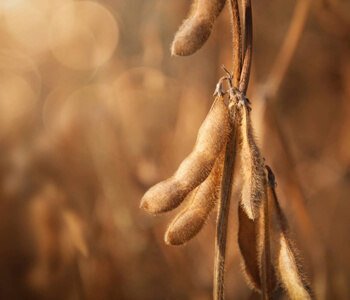
Mike Tufte
Seed Specialist
Another growing season has come and gone. It seems like the planters just started rolling, but now we are preparing for winter. As we look forward to next year, let’s look back at some key points from this past season.
Spring started off with a bang. We had some heat come early in April. In fact, we had about three days that hit the 80-degree mark, and that sparked #Plant23. Unfortunately, those few days were too good to be true. They were followed up by a couple weeks of cooler than average temperatures. Several acres of both corn and beans had been planted by then. The beans seemed to stand the temperature shift ok. The corn experienced some leafing out underground. This got me thinking, though. So, I decided to monitor Growing Degree Units (GDU) for the remainder of the season.
I put pins on a few locations throughout the Key Cooperative footprint and updated them each week. Given we didn’t get the opportunity to plant an abundance of acres in April, I used May 1 as my starting point. Since I was going to measure the GDU, I decided that I might as well monitor the monthly precipitation as well. For simplicity, let’s look at S14 and Sully. Although these locations won’t directly reflect all areas, we can get a feel for some averages and build a story from it. I used a common 109-day hybrid’s GDU ratings to determine dates for S14 and a 115-day hybrid for Sully.
S14 (Roland) is up in the dead center of Story County. It’s one of our northernmost locations. The soil tends to be a nice loam seated above a bed of sand. If we use a May 1 planting date every year, we will typically see emergence right around May 14th. In 2023, S14 saw emergence a few days earlier. Corn was popping out of the ground on May 11th. Mother Nature kept giving us warm days with evenings that didn’t cool down much. By June 9th, we were determining our cob size, as opposed to the 30-year average of June 15th. We lost a little heat at the end of June allowing that 30-year average to catch us by a few days through silking, but then that late July heat hit. Our corn blacklayered around September 17th, which is seven days earlier than normal. Anytime we have quality GDU, we increase our chances of success.
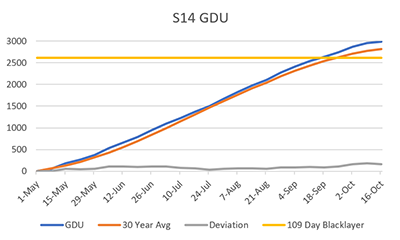
Knowing that we had a little more heat in 2023 than we have had over the course of the last 30 years, we’d like to have also had a little more rainfall. Unfortunately, we received exactly the opposite. Last year was on the dry side and we didn’t have much winter moisture to speak of. As we start looking at the growing season, we see that even with less moisture coming into the season, we continually receive less. The trends stayed on pace with each other, meaning we saw an increase through June but less through July. August looked good for the most part. September drought set in, increasing our accumulated deviation to over eight inches shy for the season. It wasn’t until October that we saw a nice spike that brought that deviation back in.
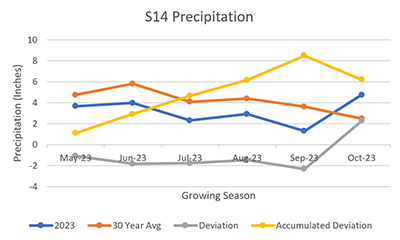
Sully GDU followed the same type of pattern that S14 did. Looking at the 30-year average, we would expect the corn to emerge on roughly May 13th, but we were seeing spikes on May 10th this year. The cob size was starting to be determined around June 8th this year, as opposed to June 15th on the average. The GDU stayed linear for the most part. There weren’t any large spreads from the deviation. Mother Nature gave us constant and steady heat. She threw a few windstorms in there, but overall gave us ideal growing conditions as far as heat goes. We were able to reach blacklayer on September 20th. That’s an entire ten days earlier than the average suggests. We had reports of some growers wrapping up corn harvest in September.
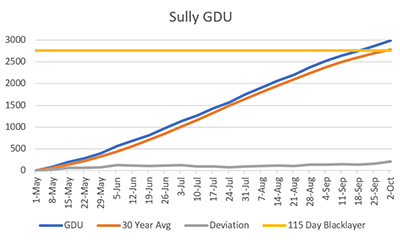
Moisture in Sully was another topic. What started off as dry only got drier. The trend typically goes up in June and falls in July. We did see this, but when the trend went back up in August, we kept falling backwards. Each month the accumulated deviation from the 30-year average grew and grew. By October, we were nearly 8.5 inches shy of normal on the growing season.
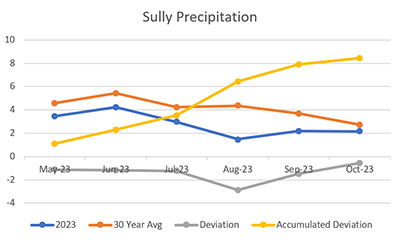
Overall, we were hot and dry. So, how do we explain the yields we were able to achieve? A few things come to mind:
2023 may have seen it’s struggles from Mother Nature, but the overall crop report looks great! Several locations had record setting, or near record setting, yields. We had quality products placed on the right acre, traits/technology where we needed them, rainfall at the optimal times, a team of dedicated staff working around the clock to take care of our growers and the best customers out there. If we want a chance to repeat that again next year, the planning needs to start now. Reach out to your Key Cooperative agronomist and start building a strategy for 2024. We are here to help you win!
Seed Specialist
Another growing season has come and gone. It seems like the planters just started rolling, but now we are preparing for winter. As we look forward to next year, let’s look back at some key points from this past season.
Spring started off with a bang. We had some heat come early in April. In fact, we had about three days that hit the 80-degree mark, and that sparked #Plant23. Unfortunately, those few days were too good to be true. They were followed up by a couple weeks of cooler than average temperatures. Several acres of both corn and beans had been planted by then. The beans seemed to stand the temperature shift ok. The corn experienced some leafing out underground. This got me thinking, though. So, I decided to monitor Growing Degree Units (GDU) for the remainder of the season.
I put pins on a few locations throughout the Key Cooperative footprint and updated them each week. Given we didn’t get the opportunity to plant an abundance of acres in April, I used May 1 as my starting point. Since I was going to measure the GDU, I decided that I might as well monitor the monthly precipitation as well. For simplicity, let’s look at S14 and Sully. Although these locations won’t directly reflect all areas, we can get a feel for some averages and build a story from it. I used a common 109-day hybrid’s GDU ratings to determine dates for S14 and a 115-day hybrid for Sully.
S14 (Roland) is up in the dead center of Story County. It’s one of our northernmost locations. The soil tends to be a nice loam seated above a bed of sand. If we use a May 1 planting date every year, we will typically see emergence right around May 14th. In 2023, S14 saw emergence a few days earlier. Corn was popping out of the ground on May 11th. Mother Nature kept giving us warm days with evenings that didn’t cool down much. By June 9th, we were determining our cob size, as opposed to the 30-year average of June 15th. We lost a little heat at the end of June allowing that 30-year average to catch us by a few days through silking, but then that late July heat hit. Our corn blacklayered around September 17th, which is seven days earlier than normal. Anytime we have quality GDU, we increase our chances of success.

Knowing that we had a little more heat in 2023 than we have had over the course of the last 30 years, we’d like to have also had a little more rainfall. Unfortunately, we received exactly the opposite. Last year was on the dry side and we didn’t have much winter moisture to speak of. As we start looking at the growing season, we see that even with less moisture coming into the season, we continually receive less. The trends stayed on pace with each other, meaning we saw an increase through June but less through July. August looked good for the most part. September drought set in, increasing our accumulated deviation to over eight inches shy for the season. It wasn’t until October that we saw a nice spike that brought that deviation back in.

Sully GDU followed the same type of pattern that S14 did. Looking at the 30-year average, we would expect the corn to emerge on roughly May 13th, but we were seeing spikes on May 10th this year. The cob size was starting to be determined around June 8th this year, as opposed to June 15th on the average. The GDU stayed linear for the most part. There weren’t any large spreads from the deviation. Mother Nature gave us constant and steady heat. She threw a few windstorms in there, but overall gave us ideal growing conditions as far as heat goes. We were able to reach blacklayer on September 20th. That’s an entire ten days earlier than the average suggests. We had reports of some growers wrapping up corn harvest in September.

Moisture in Sully was another topic. What started off as dry only got drier. The trend typically goes up in June and falls in July. We did see this, but when the trend went back up in August, we kept falling backwards. Each month the accumulated deviation from the 30-year average grew and grew. By October, we were nearly 8.5 inches shy of normal on the growing season.

Overall, we were hot and dry. So, how do we explain the yields we were able to achieve? A few things come to mind:
- Companies are breeding hybrids to withstand drought conditions better. We have been in a dry cycle for a few years. It takes five years to bring a new hybrid to the market. They select hybrids that perform to their standards to move forward with. If they are breeding in adverse conditions, those are the types of hybrids that will perform. This is why we want to stay up to date with companies that are bringing new hybrids to the market each year.
- Moisture timing is a big one. We may have been drier than normal and in some areas, we were drier than we were last growing season. The saving grace was the timing of the rainfall we received. As I look over my data sets, I can overlay the rainfall on top of the GDU map. I can see that rainfall occurred at optimal times such as V5-V6 for cob girth, V12 for cob length and during silking/pollination. We had ample time for grain fill and just enough moisture when we needed it.
- Fungicides played an important role in this year’s crop. We saw an increase in fungicide acres, and it paid off. The plants stayed healthier, which in turn correlated to yield. There were reports out in the countryside of anywhere from 12–70 bushel differences in fields that had been sprayed with fungicide vs those that had been missed. When we have poor conditions with potential disease pressures, it is of the utmost importance to utilize a quality fungicide!
2023 may have seen it’s struggles from Mother Nature, but the overall crop report looks great! Several locations had record setting, or near record setting, yields. We had quality products placed on the right acre, traits/technology where we needed them, rainfall at the optimal times, a team of dedicated staff working around the clock to take care of our growers and the best customers out there. If we want a chance to repeat that again next year, the planning needs to start now. Reach out to your Key Cooperative agronomist and start building a strategy for 2024. We are here to help you win!